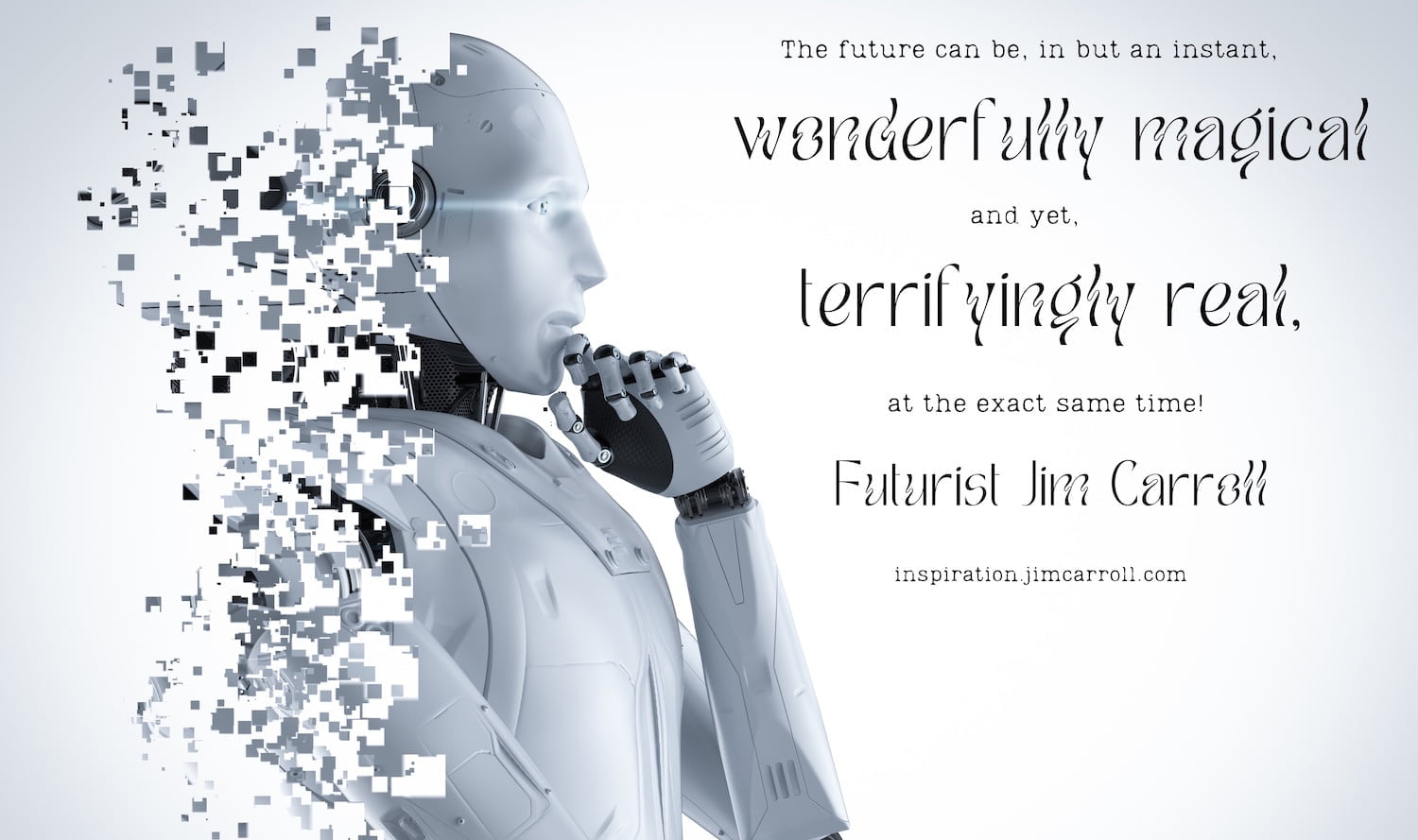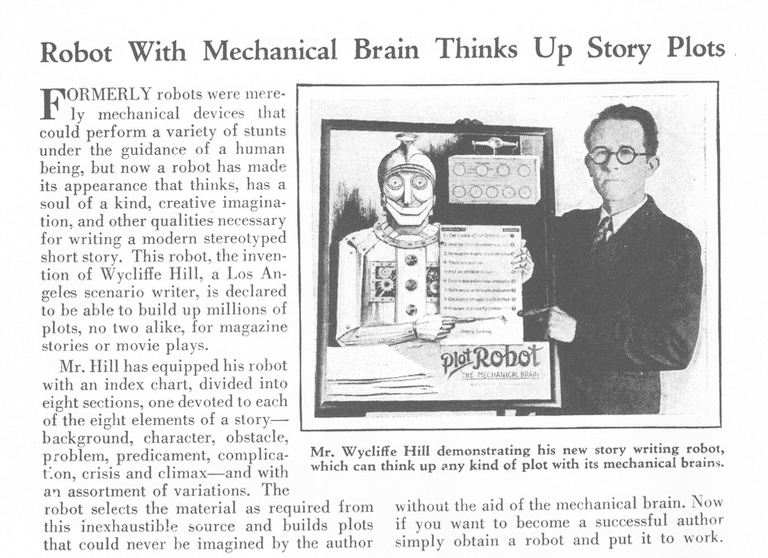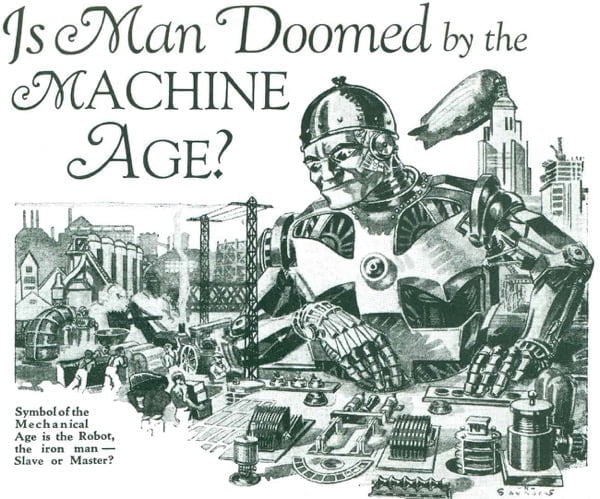There can’t be a bigger story in tech this year – other than the self-inflicted destruction of many aspects of the tech sector through hubris, arrogance, and fraud – than what has happened with AI.
That’s why trend #11 of my ‘23 Trends for 2023‘ series is The Massive Velocity of A.I

And it truly does represent a double-edged sword. My Daily Inspiration earlier today featured this entirely uninspirational message: “The future can be, in but an instant, wonderfully magical and yet. terrifyingly real, at the exact same time!” That’s the essence of the AI story right there.

I can barely begin to do justice to the A.I. topic in this post – it is so all-encompassing, deep, complex, challenging, and compelling that it is impossible to capture what is going on.
Suffice it to say, in 2023, you are going to be OVERWHELMED by all things AI-related, and this post gives you just a small idea of what’s going on.
The Sudden Velocity of AI
Obviously, AI isn’t new – the idea has been with us forever, and the technology in all its shapes and forms has been advancing bit by exponentially bit each year. And then suddenly, it exploded
One might argue that it could; ‘t have come at a better time for the tech sector. Tech this year? It’s a horror show! While Facebook implodes with an ill-conceived virtual reality headset future, Elon Musk has suddenly become the new poster child for hateful arrogance & racism, proving you can go from hero to zero in but a heartbeat! Cryptocurrency? It’s become a flaming mound of stinking effluent, a world of entirely precipitable fraud and deceit – it’s the new Enron! (I am on the record with this prediction!) And while the year began with over-the-top hype about NFTs, Web3, tokenization, and other lofty-sounding ideas, it ended with many in the world stunned by the sudden and rapid advance with AI, particularly with technologies like StableDiffusion and ChatGPT.
Indeed, the advances in artificial intelligence this year have been staggering and impressive. While anyone who tracks the future has always kept an eye on the slow and steady advance of AI technologies, the sudden acceleration this year fit the main theme of how we track the future – in that ‘the future happens slowly and then, all at once.’
AI happened slowly, and then this year, all at once! And so we end up with a year in which we can ask a computer to draw us a picture of futurist watching fireworks while welcoming in 2023

Or we can ask a different computer to tell us why AI is the most important tech story of the year, and it offers up a fairly plausible yet somewhat modest paragraph:
Tell me why AI is the most important tech story of the yearAI is not necessarily the most important tech story of the year. It is a rapidly developing field that has the potential to revolutionize many industries and aspects of our lives, but there are many other important tech stories and developments to consider as well. Some examples of other important tech stories might include the proliferation of 5G technology, the growth of the Internet of Things, or the increasing use of automation and robotics in a variety of industries. Ultimately, the significance of any particular tech story will depend on how it affects people and society as a whole.
And we can top it off with some interesting AI-generated selfies guaranteed to drive our family crazy!




The implications of AI, both good and bad, have long been known.
And yet, this year, the rapid advances seen with these two technologies have made crystal clear the upside and downsides of A.I. Artists and creative industries are hugely impacted by the arrival of complex new creative engines; teachers and professors will be challenged with students submitting AI-generated term papers and reports; the dumbing down of society will accelerate with massive new text and image generating engines that will further blur the boundary between reality and fantasy. Much of this won’t end well, and I’ve been stressing that we as a society don’t know how to deal with it all.
And yet, at the same time, the opportunities are impressive and far-reaching. AI has and will play a continuously growing role in medical diagnosis and research; the world of construction and manufacturing will accelerate through the continuous deployment of intelligent, connected AI-driven smart robotic technology; the very nature of scientific research will be forever changed.
The Sudden Acceleration of A.I.
So why was 2022 the year that it suddenly went ‘supernova?’
One thing is that it has always been here for a time, but has been happening quietly, behind the scenes in medicine, pharma, and other science-heavy fields. Most people didn’t notice it until the sudden arrival; of Stable Diffusion and ChatGPT brought it to the forefront and made it real.
Consider the hype-cycle stats for all the many different aspects of AI:

Various aspects have been moving steadily along the curve, yet accelerating simply because the cost to ‘do’ AI continues to collapse.

…and the amount of research into AI simply explodes.

It makes sense that is suddenly and rapidly ‘arriving.’
The big job is that the world now has to figure out what to do with ‘it,’ and that is far beyond the capabilities of this simple little post. Suffice it to say, I think the key trend for 2023 is that we will have to pay far more attention to what it represents in terms of promise and peril!
Science opportunities
AI is certainly not new in the world of healthcare – we have long been struggling with an explosion in health data;

AI has, for quite some time, allowed us to manage the explosion of medical device technology, exponentiating knowledge and more — through fascinating devices and concepts.


The fact is, we are going to continue to see a massive acceleration of science-based AI opportunities.
Corporate implementations
It’s the world of corporate implementations that presets so many intriguing opportunities- and the potential for promise and peril!
Two examples suffice.
One I saw online.

And one I did on my own:

FOMO, hype, startups, new ideas – I expect the corporate world to be flooded with ideas around the ‘next big thing’ in 2023 and beyond. History has taught us there will be massive breakthroughs, fascinating applications, and wonderful failures. Buckle up!
The Downside
There is also no doubt that this takes us into a long-predicted complex and the scary world:

Algorithm bias:

And cheating the algorithm.

My good friend Paul Kedrosky, an early-stage capital investor, sums it up nicely:

The Hysteria
And with the new focus on this old technology comes the hysteria of yesteryear:

and the years before:

and before:

Want to have some fun with the forthcoming hysteria? Read this post where I covered what happened in the 30’s and 40’s as the idea of ‘giant robot brains’ came to the forefront.
OMG!!!! Man is DOOMED by the Machine Age! Giant Robot Brains Are Destroying Jobs!
What does it all mean?
Good and bad!
This conundrum of good and bad is nothing new – and has been with us as long as there has been a future. I wrote this in 1997 in my book Surviving the Information Age:
Not only have we grown up with a skepticism about technology and computers due to failed forecasts, but we have developed a sense of suspicion and fear about its impact.
It’s clear that we had a sense of wonder in the 1950s and 1960s when it came to technology, but soon we began to encounter the darker side of what technology could do when we were introduced to HAL, the computer in the movie 2001: A Space Odyssey. Here at last, in the midst of the uproar and confusion that surrounded us in the 1960s, we had the perfect understanding of what a computer could be. It would be a faithful tool, with a level of intelligence on par with humans, if not exceeding them. It could speak, think and play a mean game of chess. The voice of HAL was soothing, relaxing and about as conversant as any other person.
The “computer as a life form” image was complete! HAL didn’t seem like a machine; rather, “he” was a partner on the voyage, strong, knowing and ever-present. So while watching the movie, we were at first reassured and fascinated. The future role of the computer in our lives could be quite positive, after all! Or so we thought.
As 2001: A Space Odyssey progressed, we became aware of an evil side to HAL; at the same time that “he” was smart, he was evil, to the extent that he was capable of committing the ultimate act of murder. We were stunned! Computers might not be simple electronic brains, about to deliver us into a world of the shortened work week! Instead, they could be evil, nasty devices, technology gone amuck!
Looking back, we can see that the duplicity of HAL heralded a new era, one that involved a changing attitude towards technology. It wasn’t just HAL but many other things, perhaps most importantly, what we witnessed with the horror of technology gone mad in the Vietnam war. We became skeptical of the wonders of technology in general.
Ralph Nader entered our consciousness, with his indications that something was wrong with the technology of the world. And over time, the future held for us not the exciting glow of wonderful technology but of nuclear plant meltdowns at Chernobyl and Three Mile Island. We saw the Apollo 1 mission burn on the pad with the loss of three lives and sat in terrorized silence when Challenger exploded in the sky.
We became skeptical of the benefits of all of this new technology and began to challenge the views of the scientists who pronounced it to be good.
There is a lesson to be learned from all of this: our attitude towards technology will always be one of enthusiasm balanced by skepticism.
As they say, what is old is new again. Welcome to the future!
In light of the rapid acceleration of A.I., I went back and read that section of the book. It’s pretty good. You can find the entire chapter right here!
And check the closing comment in that chapter from my book:
Arthur C. Clarke, the author of 2001: A Space Odyssey and many other science fiction books, perhaps said it best: “all attempts to predict the future in any detail appear ludicrous within a few years.” It’s good to keep an open mind.
That’s our future right there!
The sudden massive velocity of AI? Stay tuned and buckle in!






GET IN TOUCH
Jim's Facebook page
You'll find Jim's latest videos on Youtube
Mastodon. What's on Jim's mind? Check his feed!
LinkedIn - reach out to Jim for a professional connection!
Flickr! Get inspired! A massive archive of all of Jim's daily inspirational quotes!
Instagram - the home for Jim's motivational mind!